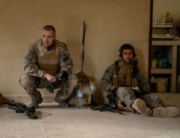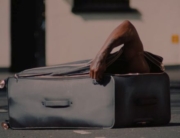The “you are there” Direct Cinema genre aims to make the viewer feel like an unobtrusive observer. The documentary Welcome to Leith falls partially in that category, with its iPhone footage of city council meetings erupting in profanity. It also has a “you could be there” tone, warning: What if white supremacists singled out your town to turn it into their heaven on earth?
The choice of Leith, North Dakota, as a possible skinhead hive was not random. Leith has only 24 inhabitants. Craig Cobb, who happily proclaims to be “one of the most famous racists on the earth,” believed land could be cheaply bought and deeded to neo-Nazis, who would then hold a majority and control the local government. In 2012, land was bought for that purpose.
To begin with, Cobb is creepy. He has a long shock of gray hair and somehow maintains an eerie smile whenever he’s insulted. Find out about his credentials and he becomes sinister. He once published online the address of a judge who insulted him; her husband and mother were subsequently killed. He is not a harmless old crank. He actively seeks the extermination of non-whites and the whites who stand with them.
When he opens the Leith floodgates, what comes in is little more than a trickle. The only other racist who comes to stay is Kynan Dutton, an Iraq War veteran who calls himself “a white civil rights activist.” The slightly built Dutton looks as though he might have been bullied growing up. Viewers could possibly be somewhat sympathetic toward him were he not also a young father raising his children to digest his bile. There is, however, a darkly humorous moment when his son, prompted about his day at school, reports that he has learned words that begin with the letter N. As the little boy starts listing them, Dutton looks nervously at the camera. His son goes on to say, “Nickel.”
Perhaps the other white supremacists don’t show up in droves because none of the available properties have running water. The town’s citizens use this against Cobb and pass an ordinance requiring access to potable water in an attempt to drive him out. Threats and harassment begin on both sides, with seemingly everyone in town arming themselves to the teeth. In a 21st century touch, both sides constantly film each other, hoping to catch an illegal act.
At issue here is the belief that at some point Cobb’s poisonous speech becomes a crime in itself. At the same time, the residents of Leith seem untroubled by the possibility of taking the law in their own hands to oppose him; there is a dubiously legal use of a bulldozer, for instance. Charges are brought, and the battle for Leith hinges on what it means to terrorize another person.
The filmmakers should be commended for the access gained to all parties involved. They give Cobb time to make his case, and he’s never as terrifying as when he sits down, with a neat haircut and nondescript clothing, and rationally and politely paints himself as a victim. That’s when “you could be there” turns into “he could be here,” as in Cobb, or someone sharing his ideology, could be the person sitting right next to you. Welcome to Leith is a fascinating, provocative film, only too relevant to our current cultural conflicts.

















Leave A Comment